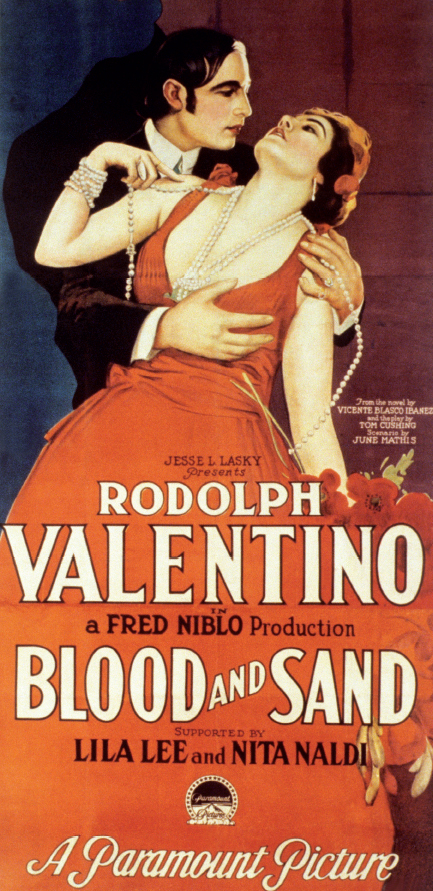Exploring American Histories: Printed Page 663
Exploring American Histories, Value Edition: Printed Page 549
Breaking with the Old Morality

Challenges to the virtues of thrift and sacrifice were ac-companied by a transformation of the moral codes of late-nineteenth-century America, especially those relating to sex. The entertainment industry played a large role in promoting relaxed attitudes toward sexual relations to a mass audience throughout the nation. The motion picture business, increasingly centered in Hollywood after 1920, attracted women and men to movie palaces where they could see swashbuckling heroes and glamorous heroines. In an era of silent movies, patrons in the nation’s twenty thousand movie houses were enthralled not by the occasional dialogue printed on the screen but by the powerfully attractive images of the film stars.
Originally shown as short films for 5 cents in nickelodeons, the movies appealed to a national audience. Melodramas and comedies entertained the masses, and films such as D. W. Griffith’s Birth of a Nation (1915) appealed to racial prejudices by glorifying the Ku Klux Klan. By the 1920s, films had expanded into feature-length pictures, Hollywood film studios had blossomed into major corporations, and movies were shown in ornate theaters in cities and towns across the country. The star system was born, and matinee idols such as Douglas Fairbanks, Charlie Chaplin, Clara Bow, and Mary Pickford influenced fashions and hairstyles. Female stars dressed as “flappers” and wooed audiences. Representing the liberated new woman, flappers wore short skirts, used ample makeup (formerly associated with prostitutes), smoked cigarettes in public, drank illegal alcoholic beverages, and gyrated to jazz tunes on the dance floor.
Americans could enjoy new entertainment opportunities and still remain faithful to traditional values. By 1929 approximately 40 percent of households owned a radio and could listen to stations affiliated with the two major broadcasting networks: the Columbia Broadcasting System (CBS) and the National Broadcasting Company (NBC). Shows such as The General Motors Family and The Maxwell House Hour blended product advertising with family entertainment. Amos ’n’ Andy garnered large audiences by satirizing black working-class life, which, intentionally or not, reinforced racist stereotypes. In cities like New York and Chicago, immigrants could tune in to foreign-language radio programs aimed at non-English-speaking ethnic groups, which offered them an outlet for preserving their identity in the face of the increasing homogeneity fostered by the national consumer culture.
The most spirited challenge to both traditional values and the modern consumer culture came from a diverse group of intellectuals known as the Lost Generation. Gertrude Stein coined the term to describe the disillusionment that many of her fellow writers and artists felt after the ravages of World War I. Already concerned about the impact of mass culture and corporate capitalism on individualism and free thought, they focused their talents on criticizing what they saw as the hypocrisy of old values and the conformity ushered in by the new. In the novel This Side of Paradise (1920), F. Scott Fitzgerald complained that his generation had “grown up to find all Gods dead, all wars fought, all faith in man shaken.” In a series of novels, including Main Street (1920), Babbitt (1922), and Elmer Gantry (1927), Sinclair Lewis ridiculed the narrow-mindedness of small-town life, the empty materialism of businessmen, and the insincerity of evangelical preachers. Journalist Henry Louis (H. L.) Mencken picked up these subjects in the pages of his magazine, The American Mercury. From his vantage point in Baltimore, Maryland, he lampooned the beliefs and behavior of Middle America and groused that its residents had turned democracy into “boobocracy,” or government by boobs.
While radio audiences howled with laughter over the exploits of Amos ’n’ Andy, scholars discredited conventional wisdom about race. Challenging studies that purported to demonstrate the intellectual superiority of whites over blacks, Columbia University anthropologist Franz Boas argued that any apparent intelligence gap between the races resulted from environmental factors and not heredity. His student Ruth Benedict further argued that the culture of so-called primitive tribes such as the Pueblo Indians, which emphasized cooperation and spiritual ideals, produced a less stressful and more emotionally connected lifestyle than that of more advanced societies. The ideas of Sigmund Freud, an Austrian psychoanalyst, shifted emphasis away from culture and race to individual consciousness. His disciples stressed the role of the unconscious mind and the power of the sex drive in shaping human behavior, beliefs that gained traction not only in university education but also in advertising appeals.